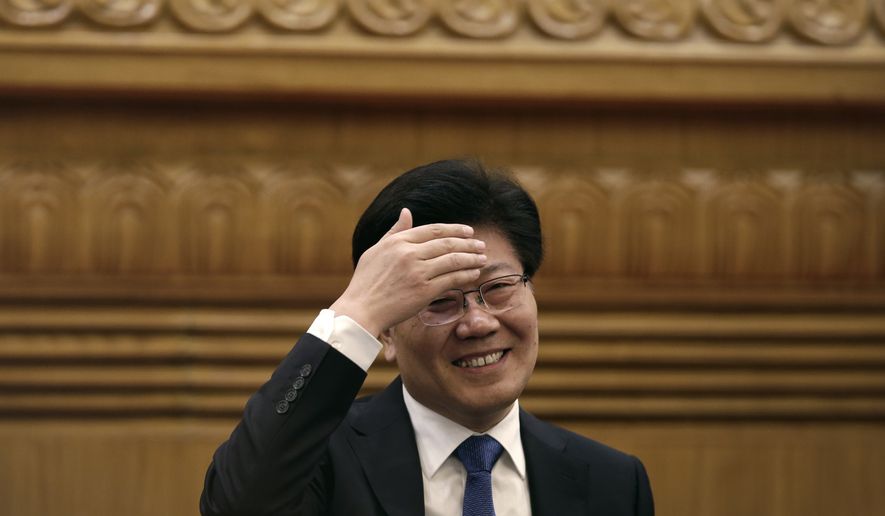A key Chinese official claimed Tuesday that ethnic Uighurs who once fought with the Islamic State in Syria and Iraq have returned with plots to attack China, an assertion that quickly drew scrutiny in Washington but underscored the increasingly global reach of the extremist outfit that has drawn more foreign fighters than any other jihadi movement in decades.
While analysts cautioned that Beijing has a habit of promoting false information to justify crackdowns on Uighur dissents in China’s far-western Xinjiang province, some saw the very mention of a link to the Islamic State as fresh evidence of the group’s relevance on the world stage.
The development arrives during a week in which the Islamic State, also known by the acronyms ISIS and ISIL, has again made headlines on the other side of the world where the leader of the brutal Nigeria-based Islamist Boko Haram group pledged allegiance to Islamic State leader Abu Bakr al-Baghdadi, after similar declarations by groups in Egypt and Libya.
But U.S. officials say they remain most concerned by the seemingly limitless number of foreign fighters willing to travel to fight with the group in Syria and Iraq. “The sheer number of foreign fighters,” National Counterterrorism Center Director Nicholas J. Rasmussen told the Senate Select Committee on Intelligence last month, “threatens to overwhelm the law enforcement and intelligence capabilities of some of our key partners around the world.”
At least 20,000 foreign fighters have traveled to the war zone and many can be expected to return home one day, Mr. Rasmussen said. It’s a number that far surpasses the roughly 5,000 said to have traveled from a host of Middle Eastern and North African nations to Afghanistan during the 1980s to fight the Soviet invasion.
Several thousand of those now fighting in Syria and Iraq have come from Europe, raising the threat of attacks on the U.S. given the relative ease of travel from Europe to the U.S.
“At least 3,400 of them are from Western Europe, and that includes visa-waiver countries, where they are a plane ticket away from the United States,” Mr. Rasmussen warned last month.
The London-based International Center for the Study of Radicalization and Political Violence recently reported that nearly half of all foreign fighters flowing into the war zone come from four nations: Tunisia, Saudi Arabia, Jordan and Morocco. Among European nations cited in the center’s data, Russia, France and Germany are prominent. As many as 1,500 of the foreign fighters have come from Russia, some 1,200 from France and as many as 600 from Germany.
U.S. officials say more than 100 have come from within the United States.
The China connection
Drawing the links between the Islamic State and groups in the Far East is more difficult, analysts and officials say.
U.S. officials have said that more than 1,000 people from Southeast Asia have traveled to the Middle East to join the Islamic State, and authorities in Indonesia — the world’s most populous Muslim nation — have been particularly wary during recent months.
The situation in China is more complex, analysts say. Battling sometimes violent separatist groups, Beijing has a clear interest in exaggerating the terrorist ambitions of the nation’s Muslim Uighur ethnic minority to justify heavy-handed policing in Xinjiang.
Zhang Chunxian, the Communist Party secretary of the province, claimed Tuesday that an unspecified number of Uighurs have “fled overseas and joined the Islamic State.”
“We have also found that some who fought returned to Xinjiang to participate in terrorist plots,” Mr. Zhang said.
He made the comments in Beijing as Chinese lawmakers gathered for an annual session of parliament. Other regional representatives said authorities are preparing to strengthen a crackdown on terrorism and extremism in Xinjiang, according to The Associated Press.
Uighurs have bristled under what they say is repressive Chinese government rule. Attacks have been blamed on members of the ethnic minority in the province and in other parts of China, including an incident in which a car plowed into a crowd at Beijing’s Tiananmen Gate in 2013, killing five people.
Mr. Zhang’s claim follows a December report by The Global Times, a newspaper tied to China’s ruling Communist Party, which maintained that some 300 Chinese have traveled to fight with the Islamic State in Syria and Iraq.
China analysts in Washington generally have not disputed the report, but some have viewed it with skepticism.
“Xinjiang is of great strategic importance to China right now,” said Sean Roberts, a professor and Uighur analyst at George Washington University.
He noted that Beijing is pumping development funds into the province with “plans to increase access to markets and natural resources across central and South Asia and beyond.”
Any unrest or push for autonomy in the province harms those objectives, Mr. Roberts said.
“Painting Uighur dissent as something connected to a global jihadist movement rather than to domestic issues,” he said, “is a way for Beijing to essentially deflect blame from the Chinese government for why Uighurs might be displaying discontent in the first place.”
Patrick Cronin, who heads the Asia-Pacific Security Program at the Center for a New American Security, agreed.
“On the surface,” he said, “China and the United States share a common interest in controlling the recruitment, terrorism and reach of ISIS.
“Beneath the surface, however, China conflates separatists with terrorists, and it is not beneath Chinese officials to sweep up the former with the latter,” Mr. Cronin said. “I would not be surprised to find some 300 Uighurs have gone off to fight for ISIS, but I would be surprised if the crackdown on Xinjiang were mostly related to this apparent fact.”
• Guy Taylor can be reached at gtaylor@washingtontimes.com.




Please read our comment policy before commenting.